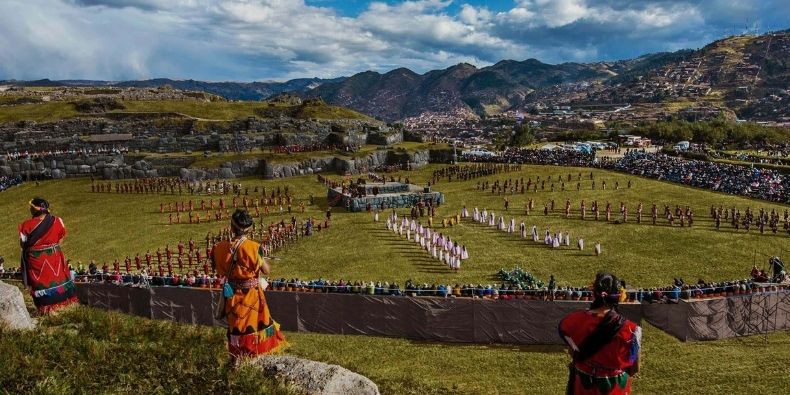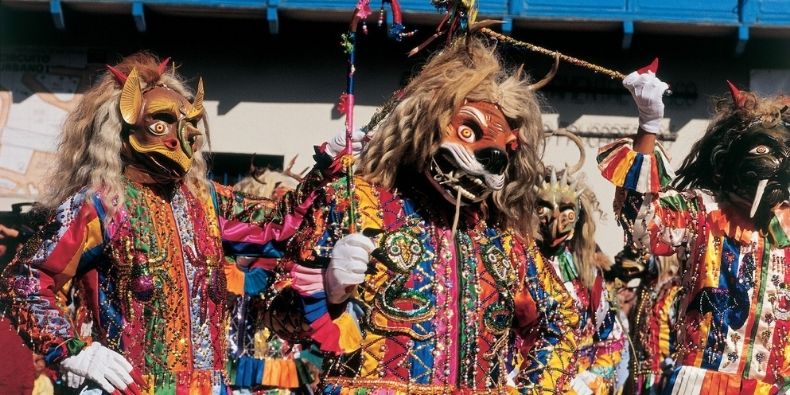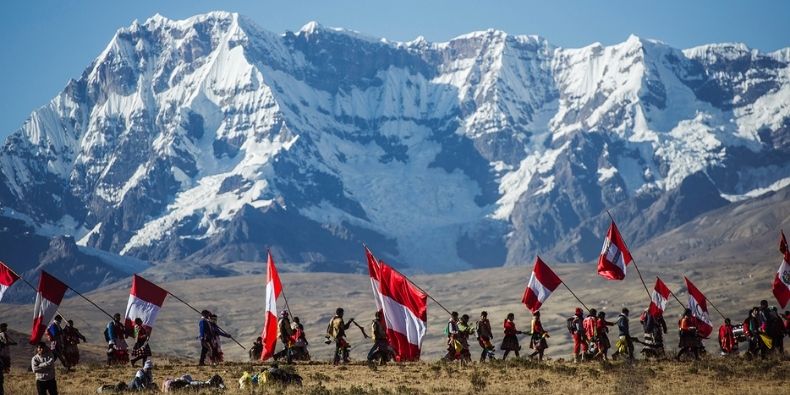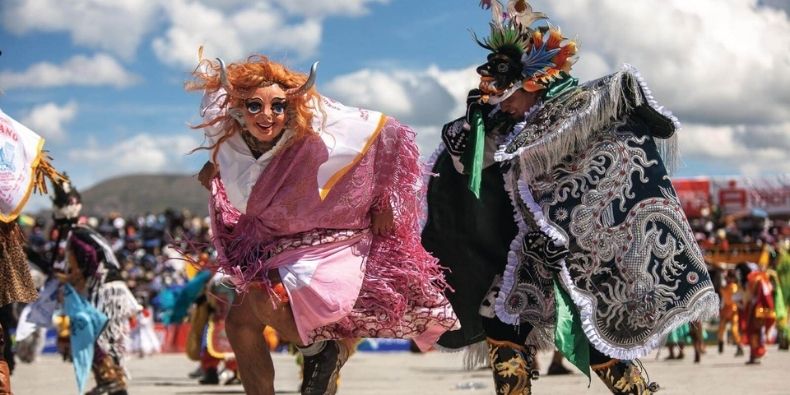The diversity of Peru comes from an evolution of cultures and societies traced back to the pre-Hispanic era, where each of them contributed to the development of new traditions, being the Incas the perfect example of it.
As time passed by and new customs were introduced, it resulted in a mixture of beliefs and traditions that now add a special touch to our cultural heritage. According to the Peruvian National Institute of Statistic and Informatic, Peru celebrates 6,882 cultural manifestations.
Most of these celebrations are known to range between civic and religious festivals, some of them established to promote internal tourism and others for the regional development of the country. However, not all of them are widely known as the ones we’ll mention in this blog.
These cultural celebrations offer a glimpse at the different cultures in our country and commemorate the memory of our ancestors. If you’re looking to add that special cultural touch to your journey through Peru, here are five of the most traditional celebrations!
Inti Raymi: Festival of the Sun

The Inti Raymi was the main cultural celebration in the time of the Incas, It was established by the Inca Pachacuti in 1412 A.D., a tradition that has been kept alive since generations to commemorate the winter solstice and the Sun God Inti.
This colorful and sumptuous festival was celebrated across the entire Tahuantinsuyo empire and lasted for about 8 days. In spite of the extirpation of idolatries imposed by the Spanish colonizers, it continued to be celebrated in secret by different Andean and Quechua communities.
However, it wasn’t until 1944 that the ancient ritual was recovered from oblivion and unveiled to the world. Nowadays, over 600 actors and dancers recreate this outstanding festival, honoring their ancestors and Andean beliefs once a year.
The Inti Raymi was declared Cultural Heritage of Peru and Ritual Ceremony of National Identity in 2001. It is currently celebrated every June 24th in several locations within Cusco city such as the Qorikancha Temple, Plaza de Armas of Cusco and the Ceremonial Fortress of Sacsayhuaman.
Virgen Del Carmen Festival

The Virgin of Carmen Festival began in 1662 by influence of the Spanish colonizers. Later the organization passed to the control of the local population, something that makes it possible to mold the event to the format known today.
The 1.30-meter statue holding the little baby Jesus with its left arm and a staff or scepter with its right hand would have been a gift sent by the Spanish crown in the 16th century. This same image was personally crowned by Pope John Paul II in 1985 in the city of Cusco.
According to this +400 year tradition, the organizers of the festivals as well as the coordinators of the fourteen participating folkloric groups finance the event on a voluntary basis, as well as all the food and drinks distributed to its participants, totally free of charge during the days of celebration.
This is one of the largest and most famous festivals in southern Peru, the Virgen de Carmen or “Mamacha Carmen” as it is also called, attracts thousands of visitors every year, both national and foreign. The festivities take place in the streets of the Paucartambo town in Cusco, day and night, with lots of music, dancing, food, drink and joy.
The event begins on July 15th at 7:00 am. At noon the party officially starts with fireworks, lots of music and typical dances. Several local authorities and regional personalities will participate in the opening of the festival.
Señor de los Temblores Festival

This is one of the most important Catholic festivals in the city of Cusco, it is celebrated between the second half of March and the first week of April every year. The Lord of Tremors or Lord of Earthquakes, as it is translated from Spanish, is the city’s patron saint.
According to the story, a terrifying earthquake struck the Cusco region in March 31st 1650, that’s when a group of devote people took the Holy Christ sculpture out in procession to to appease the divine wrath.
The earthquake stopped and this famous catholic image was put at the gates of the Cathedral of Cusco, facing the city, with the belief that it would placate the constant aftershocks that affected the Imperial City. For that reason, the Holy Christ was baptized as the Señor de los Temblores, or Lord of Tremors in English.
Once a year the image leaves the cathedral to travel through the main streets of the historic center, making stops at the various altars set up along the way. Representatives from all of the city’s institutions and authorities participate. The procession culminates with the blessing of the Black Christ to all the faithful.
Señor de Qoyllority Festival

This event presents a great syncretism and the fusion of the Catholic faith with ancestral indigenous customs. The festival consists of a processional walk to the Nevado Ausangate foothills, located over 4,700 meters above sea level.
According to the story, the Lord of Qoyllority appeared to a young boy of this region in the shape of a kid, who is thought to be Jesus as a child. Apparently, Jesus was dressed up as a poor child and both of them became friends.
It is said that when the village child returned home, his parents saw him and the child dressed in luxurious clothes, and seeing the brilliance of the Child Jesus, they informed the local parish priest who decided to go in search of him.
The legend says that the child Jesus fled while being chased by the parish priest who did not manage to capture him and the child Jesus then became the image of the rock to which nowadays pilgrimages are made.
Virgen de la Candelaria Festival

The Virgen de la Candelaria celebration is one of the biggest festivals in southern Peru and takes place in the country’s folkloric capital, Puno, which is located right at the shores of Lake Titicaca.
This outstanding event attracts a great multitude of foreign and national travelers that wish to see the thousands of dancers and musicians that worship and pay homage to the so-called Candelaria Mamacha for several days.
The celebrations take place in the first half of February, although the main festival is carried out on February 12th. Around 170 groups attend this festival, each of them from Quechua and Aymara communities of the different regions of Puno.
There are different stories that look to show the origin of this tradition. One of them is about a rebellious attack against the city of Puno, led by Túpac Catari and Pedro Vilcapaza de Azángaro.
Apparently, the city was outnumbered so its inhabitants decided to take the Virgen de la Candelaria out in procession, asking for protection during the whole night. Later, they realized how their rivals fled the place almost immediately.
Another story says that the Virgin appeared to a native person that was taking care of his master’s house, which was situated by a river at the foothills of the Huajsapata mount.
She then asked permission to wash her child’s clothes in a river. The caretaker of the house went in haste to call the owner of the property. When they returned they found an image of the Virgin of Candelaria with the clothes still wet.
These are just a few of the many cultural celebrations in the ancient country of the Incas, but certainly the most important. These events boast the colorful traditions of Peru, some of them deeply rooted in the heart of our people since hundreds of years ago.
Don’t miss the chance of experiencing Peru at its fullest! Make the most of your adventure with our travel packages to Machu Picchu and explore these beautiful Andean lands like a total expert.

